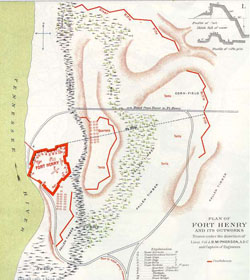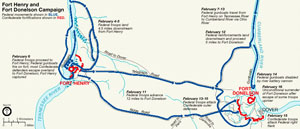 |
Civil War Battles |
|
State War Records |
| AL - AK - AZ - AR - CA - CO - CT - DE - FL - GA - HI - ID - IL - IN - IA - KS - KY - LA - MA - MD - ME - MI - MN - MS - MO - MT - NE - NV - NH - NJ - NM - NY - NC - ND - OH - OK - OR - PA - RI - SC - SD - TN - TX - UT - VT - VA - WA - WV - WI - WY |
The Battle of Fort Henry
February 6, 1862 in Fort Henry, Tennessee
 |
|||||||||||||||||||||
|
On January 30, Gen. Ulysses S. Grant at last received the reluctant permission of Gen. Henry W. Halleck to attempt to capture Fort Henry, a Confederate earthwork fort on the Tennessee River just south of Kentucky that was one of a string of outposts built to protect Confederate territory. This would be the first attempt to penetrate the western Confederacy by using major rivers as lines of operations.
Brig. Gen. Lloyd Tilghman had fewer than 3,400 poorly equipped troops to defend Fort Henry. By early February, several of the antiquated cannon were underwater due to flooding and the rest were in danger of being submerged. Neither Gen. Albert S. Johnston nor Brig. Gen. Leonidas Polk could supply the help he needed. Tilghman knew his post was indefensible.
Grant landed his 1st Division north of Panther Creek, which flowed westward into the Tennessee River about 3 miles north of the fort. The division was to swing around the creek and approach the fort from the east, cutting off the garrison's escape. As soon as the transports could return with the 2nd Division, it would seize the high ground, occupied by unfinished Fort Heiman, which commanded low-lying Fort Henry. Flag Officer Andrew H. Foote would bombard the fort from his 7 gunboats, whose firepower was several times greater than the Tilghman commanded.
Tilghman made the sensible decision not to sacrifice his men. On February 6th, as the Federals approached, he started most of his troops to Fort Donelson, 10 miles away. Then he returned to join the Tennessee artillerymen, whom he asked to delay the Federals for an hour. They did better than that and inflicted some damage on the gunboats before their 2 effective guns were disabled. Honor had been satisfied, and Tilghman surrendered. The Union officers who accepted the surrender entered Fort Henry by rowing through the sallyport. To the delight of the navy, Grant arrived after the surrender.
Three gunboats then raided 150 miles upstream to Muscle Shoals, Alabama destroying bridges and boats in a spectacular demonstration of the importance of controlling the rivers.
Fort Henry's fall opened the Tennessee River to Union gunboats and shipping as far as Muscle Shoals. After the fall of Fort Donelson, 10 days later, the 2 major water transportation routes in the Confederate west, bounded by the Appalachians and the Mississippi River, became Union highways for movement of troops and material


